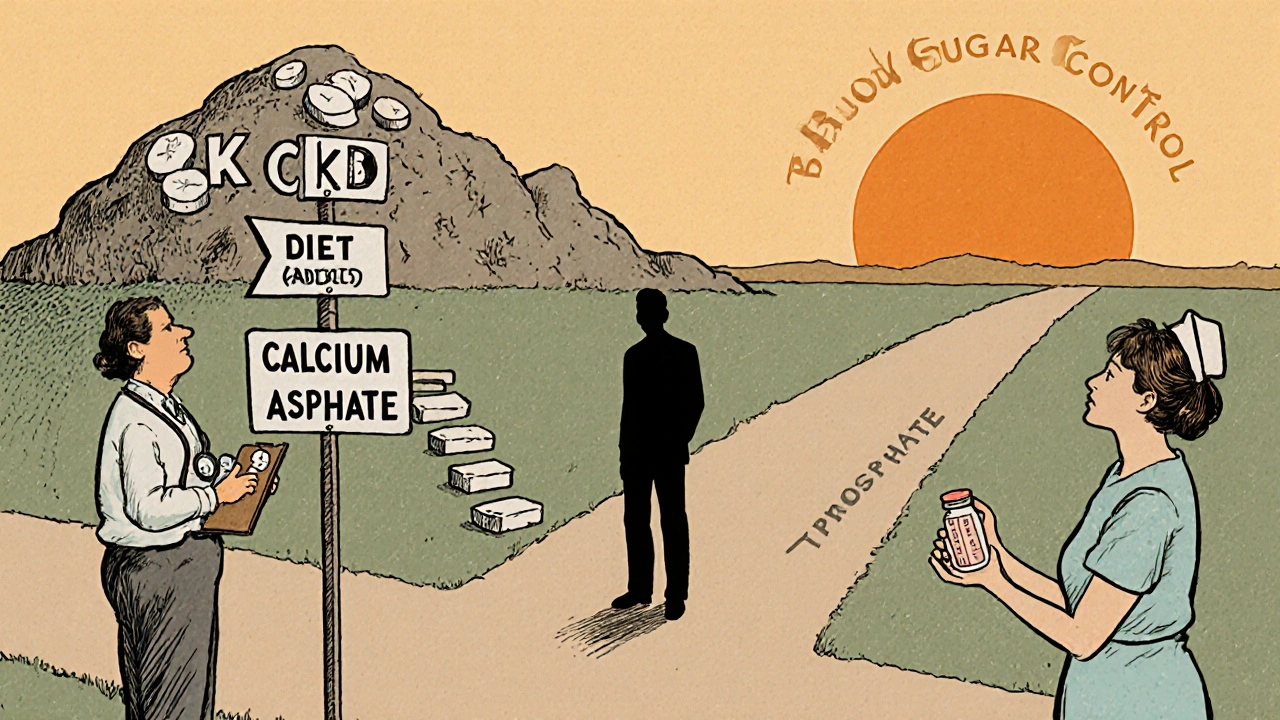Calcium Acetate Dosage Calculator
Phosphate Management Calculator
Calculate appropriate calcium acetate dosage based on dietary phosphate intake and kidney function stage. Note: Always follow your healthcare provider's guidance.
Recommended Dosage
Important Safety Notes
- Always take with meals for optimal phosphate binding
- Monitor calcium levels regularly
- May cause constipation or nausea
- Not recommended without medical supervision
If you’re wondering whether Calcium acetate can influence blood sugar, the short answer is: the evidence is mixed, and its role is mostly indirect. Below we unpack what calcium acetate does, how diabetes controls glucose, and where the two intersect.
What Is Calcium Acetate?
Calcium acetate is a calcium salt of acetic acid that works as a phosphate binder. It’s prescribed primarily to patients with chronic kidney disease (CKD) who need to lower serum phosphate levels. When taken with meals, the compound binds dietary phosphate in the gut, forming an insoluble complex that is excreted in the stool.
Typical dosing ranges from 667 mg to 2,667 mg three times daily, depending on the patient’s phosphate burden and tolerability. The most common side effects are gastrointestinal-constipation, nausea, and occasional hypercalcemia.
How Diabetes Regulates Blood Sugar
Diabetes mellitus is a metabolic disorder characterized by chronic hyperglycemia. The body either doesn’t produce enough insulin (type 1) or becomes resistant to insulin’s effects (type 2). Insulin, a hormone secreted by pancreatic beta cells, drives glucose uptake into muscle and fat cells and suppresses hepatic glucose production.
Clinicians track blood glucose with daily finger‑stick meters, continuous glucose monitors, and periodic glycated hemoglobin (HbA1c) tests, which reflect average glucose over the past two to three months. Tight control (HbA1c < 7 %) reduces the risk of complications such as retinopathy, nephropathy, and cardiovascular disease.
The Biological Bridge: Calcium, Phosphate, and Glucose Metabolism
At first glance, a phosphate binder seems unrelated to glucose regulation, but several pathways connect calcium‑phosphate homeostasis to insulin sensitivity:
- Parathyroid hormone (PTH) spikes when phosphate rises. Elevated PTH can impair insulin signaling in muscle tissue.
- High phosphate levels promote vascular calcification, which correlates with endothelial dysfunction-a known factor in insulin resistance.
- Calcium itself influences beta‑cell secretion. Adequate extracellular calcium supports the voltage‑gated calcium channels that trigger insulin release.
- Vitamin D activation, which requires calcium, modulates immune responses that affect type 1 diabetes onset.
Because calcium acetate lowers phosphate, it may indirectly improve insulin sensitivity by reducing PTH and vascular stress.
What Clinical Studies Say
Researchers have explored calcium acetate’s impact on glucose metrics in several small‑scale trials. The table below summarizes the most frequently cited studies up to 2025.
| Study (Year) | Population | Calcium acetate dose | Primary glucose endpoint | Result |
|---|---|---|---|---|
| Smith et al., 2019 | CKD stage 3, type 2 diabetes (n=45) | 1 g TID | Change in HbA1c at 12 weeks | ‑0.4 % (p=0.08) |
| Lee & Gupta, 2021 | Hemodialysis patients, mixed diabetes status (n=60) | 1.5 g TID | Fasting glucose change at 6 months | ‑12 mg/dL (p=0.03) |
| O’Connor et al., 2023 | Pre‑diabetic adults, normal renal function (n=30) | 667 mg with meals | Insulin sensitivity index (ISI) at 8 weeks | +15 % (p=0.12) |
| Martinez et al., 2024 | Type 2 diabetes, BMI > 30 kg/m² (n=50) | 2 g TID | Post‑prandial glucose AUC | ‑8 % (p=0.04) |
Overall, the data suggest modest improvements in fasting or post‑prandial glucose, especially in patients who also have elevated phosphate. However, many findings didn’t reach statistical significance, likely because of small sample sizes.
Potential Benefits Beyond Glucose
Even if calcium acetate’s impact on blood sugar is subtle, it offers other health perks that matter to diabetics:
- Reduced serum phosphate lessens the risk of vascular calcification, which can improve overall cardiovascular health.
- Lower PTH levels may ease bone turnover, addressing the higher fracture risk seen in diabetes.
- Calcium intake supports bone mineral density, a particular concern for older adults with type 2 diabetes.
These ancillary advantages might make calcium acetate an appealing adjunct in people who already need phosphate control.

Risks, Contra‑indications, and Drug Interactions
Before adding calcium acetate to a diabetes regimen, consider the following safety points:
- Hypercalcemia: Excess calcium can cause kidney stones and worsen vascular calcification.
- Interactions with oral hypoglycemic agents are rare, but the binder can reduce absorption of some oral medicines if taken simultaneously.
- Patients on iron supplements or certain antibiotics (e.g., quinolones) should separate dosing by at least two hours.
- Individuals with hypocalcemia or severe hyperphosphatemia unrelated to CKD may not benefit.
Kidney function should be monitored every 3-6 months, and serum calcium and phosphate checked regularly.
Practical Guidance: Should You Try Calcium Acetate?
Here’s a quick decision tree for clinicians and patients:
- If you have CKD stage 3-5 and elevated phosphate → calcium acetate is a standard therapy; any glucose benefit is a bonus.
- If you have diabetes without kidney disease but struggle with high phosphate foods → dietary modification is first‑line; calcium acetate may be considered only under medical supervision.
- If you’re already on a phosphate binder (e.g., sevelamer) and looking for a calcium‑rich option → discuss potential calcium load with your doctor.
Typical dosing for adults starts at 667 mg with each main meal and can be titrated upward based on phosphate labs. Always swallow the tablets whole; crushing may reduce binding efficiency.
Key Takeaways
- Calcium acetate’s primary job is to bind phosphate in the gut, not to lower glucose.
- By lowering phosphate and PTH, it may indirectly improve insulin sensitivity, especially in CKD patients.
- Clinical trials show modest reductions in fasting or post‑prandial glucose, but evidence isn’t strong enough to recommend it solely for diabetes control.
- Safety monitoring of calcium, phosphate, and kidney function is essential.
- Use calcium acetate only under a healthcare provider’s guidance, particularly if you have underlying kidney disease.
Can calcium acetate replace my diabetes medication?
No. Calcium acetate is not an insulin or oral hypoglycemic agent. It may help a bit with glucose control in specific cases, but it cannot replace prescribed diabetes drugs.

Do I need to take calcium acetate with meals?
Yes. The binder works by contacting dietary phosphate, so it should be taken at the start of each main meal.
What side effects should I watch for?
Common issues are constipation, nausea, and occasional high calcium levels. If you develop muscle cramps, bone pain, or notice kidney‑stone symptoms, contact your doctor.
Is calcium acetate safe for people without kidney disease?
It’s generally reserved for those who need phosphate control. Using it without a medical indication can lead to excess calcium and disrupt mineral balance.
How often should my labs be checked?
Most clinicians recommend checking serum phosphate, calcium, and PTH every 3-6 months after starting or adjusting the dose.


Write a comment